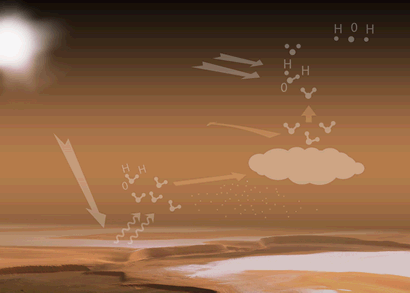ESA orbiter discovers water supersaturation in the Martian atmosphere
29 September 2011
New analysis of data sent back by the SPICAM spectrometer on board ESA's Mars Express spacecraft has revealed for the first time that the planet's atmosphere is supersaturated with water vapour. This surprising discovery has major implications for understanding the Martian water cycle and the historical evolution of the atmosphere.
 |
|
Mars Express is one of numerous spacecraft to have visited the Red Planet. Credit: ESA |
This lack of direct measurements has meant that descriptions of the vertical distribution of water vapour – a key factor in the study of Mars' hydrological cycle – has generally been based upon global climate models.
This gap in the data has now been addressed by the SPICAM (Spectroscopy for Investigation of Characteristics of the Atmosphere of Mars) imaging spectrometer on Mars Express.
The instrument can be used in occultation mode, when it studies light from the Sun that has passed through the planet's atmosphere just after sunrise or before sunset. The measurements can then be analysed to generate vertical concentration profiles for several atmospheric constituents, including water vapour.
Surprising new results, based on SPICAM data obtained during the northern spring and summer, indicate that the vertical distribution of water vapour in the Martian atmosphere is very different from previous assumptions.
Writing in this week's issue of the journal Science, an international team led by Luca Maltagliati of the Laboratoire Atmosphères, Milieux, Observations Spatiales (LATMOS) in Guyancourt, France, describe SPICAM observations at infrared wavelengths that for the first time provide evidence for the existence of supersaturated water vapour on Mars.
Supersaturation
The atmosphere of Mars holds
Under normal conditions on Earth, water vapour condenses around tiny dust or aerosol particles or salts when the atmospheric temperature drops below a certain "dew point". The atmosphere is then said to be "saturated", since it cannot hold any more moisture at that temperature and pressure. Any water vapour in excess of the "dew point" will normally condense to form droplets or icy crystals.
However, supersaturation may occur when some of the water vapour remains in the atmosphere, instead of condensing or freezing. When condensation nuclei (assumed to be dust aerosols on Mars) are too rare, condensation is impeded, leaving substantial amounts of excess vapour.
 |
|
Transport of water vapour in the Martian atmosphere. (Click on the image for more detail on the processes depicted.) Credit: ESA/AOES Medialab |
Until now, it was generally assumed that such supersaturation cannot exist in the cold Martian atmosphere: any water vapour in excess of saturation was expected to be converted immediately into ice. However, the SPICAM data have revealed that supersaturation occurs frequently in the middle atmosphere – at altitudes of up to 50 km above the surface – during the aphelion season, the period when Mars is near its farthest point from the Sun.
Extremely high levels of supersaturation were found on Mars, up to 10 times greater than those found on Earth. Clearly, there is much more water vapour in the upper Martian atmosphere than anyone ever imagined. It seems that previous models have greatly underestimated the quantities of water vapour at heights of 20–50 km, with as much as 10 to 100 times more water than expected at this altitude.
"The vertical distribution of water vapour is a key factor in the study of Mars' hydrological cycle, and the old paradigm that it is mainly controlled by saturation physics now needs to be revised," said Luca Maltagliati. "Our finding has major implications for understanding the planet's global climate and the transport of water from one hemisphere to the other."
"The data suggest that much more water vapour is being carried high enough in the atmosphere to be affected by photodissociation," added Franck Montmessin, also from LATMOS, who is the Principal Investigator for SPICAM and a co-author of the paper.
"Solar radiation can split the water molecules into oxygen and hydrogen atoms, which can then escape into space. This has implications for the rate at which water has been lost from the planet and for the long-term evolution of the Martian surface and atmosphere."
The new paper analyses SPICAM data obtained when the Martian atmosphere is relatively dust-free. The absence of dust enables the instrument to measure the vertical profile to within 10 km of the planet's surface. The supersaturation levels are likely to plummet in the southern summer, when dust storms inject large amounts of aerosols into the atmosphere, increasing the supply of condensation nuclei.
Reference publication
"Evidence of Water Vapor in Excess of Saturation in the Atmosphere of Mars", by L. Maltagliati, F. Montmessin, A. Fedorova, O. Korablev, F. Forget, and J.-L. Bertaux, published in the 30 September 2011 issue of Science.
Contacts
Luca Maltagliati
Laboratoire Atmosphères, Milieux, Observations Spatiales (LATMOS)
78280 Guyancourt
France
Email: luca.maltagliati latmos.ipsl.fr
latmos.ipsl.fr
Phone: +33 1 80 28 52 82
Franck Montmessin
Laboratoire Atmosphères, Milieux, Observations Spatiales (LATMOS)
78280 Guyancourt
France
Email: franck.montmessin latmos.ipsl.fr
latmos.ipsl.fr
Phone: +33 1 80 28 52 85
Olivier Witasse
Mars Express Project Scientist
Research and Scientific Support Department
Directorate of Science & Robotic Exploration
ESA, The Netherlands
Email: owitasse rssd.esa.it
rssd.esa.it
Phone: +31 71 5658015

